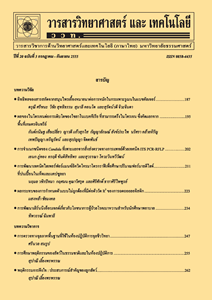ความเข้มข้นของก๊าซคาร์บอนไดออกไซด์ภายในระบบขนส่งมวลชนทางบกในเขตกรุงเทพมหานคร
Main Article Content
Abstract
บทคัดย่อ
การศึกษานี้กระทำการตรวจวัดความเข้มข้นของก๊าซคาร์บอนไดออกไซด์ภายในรถไฟฟ้าบีทีเอส รถไฟฟ้าใต้ดิน รถโดยสารประจำทางปรับอากาศ และรถตู้โดยสาร ประเภทละ 3 ซ้ำ โดยใช้เครื่องมือที่อ่านค่าได้เลยในทันทีเพื่อเปรียบเทียบกับค่ามาตรฐานของ American Society of Heating and Air-Conditioning Engineers (ASHRAE) ซึ่งกำหนดความเข้มข้นของก๊าซคาร์บอนไดออกไซด์ไว้ที่ 1,000 ppm อันแสดงถึงการระบายอากาศที่มีประสิทธิภาพ ผลการตรวจวัดพบว่าในรถไฟฟ้าบีทีเอสมีความเข้มข้นของก๊าซคาร์บอนไดออกไซด์ 430-2,225 ppm (ผู้ใช้บริการ 8-168 คน) โดยจำนวนคนเฉลี่ยในตู้โดยสารที่ไม่ทำให้ความเข้มข้นของก๊าซคาร์บอนไดออกไซด์เกินค่ามาตรฐาน คือ 75 คนต่อตู้โดยสาร ขณะที่รถไฟฟ้าใต้ดินพบก๊าซคาร์บอนไดออกไซด์ 364-2,544 ppm (ผู้ใช้บริการ 6-250 คน) จำนวนคนเฉลี่ยที่ไม่ทำให้ระดับก๊าซเกิน 1,000 ppm คือ 73 คน ต่อตู้โดยสาร ส่วนรถโดยสารประจำทางปรับอากาศพบก๊าซคาร์บอนไดออกไซด์ 458-3,546 ppm (ผู้ใช้บริการ 5-73 คน) และรถตู้โดยสารพบอยู่ในช่วง 760-7,316 ppm (ผู้โดยสารสูงสุด 16 คน) ซึ่งนอกจากจำนวนผู้ใช้บริการจะมีผลต่อระดับของก๊าซคาร์บอนไดออกไซด์แล้ว สภาพการจราจรยังส่งผลต่อความเข้มข้นของก๊าซคาร์บอนไดออกไซด์ภายในรถอีกด้วย โดยสันนิษฐานว่าอากาศจากภายนอกมีการปนเปื้อนเข้าสู่รถโดยสาร ซึ่งในรถตู้โดยสารสาธารณะมีจำนวนผู้โดยสารน้อยที่สุดในระบบขนส่งมวลชนทั้งหมด แต่มีความเข้มข้นของก๊าซคาร์บอนไดออกไซด์สูงที่สุด สรุปได้ว่าการระบายอากาศภายในระบบขนส่งมวลชนที่ทำการศึกษาทุกประเภทมีประสิทธิภาพไม่เพียงพอ โดยมีความเข้มข้นของก๊าซคาร์บอนไดออกไซด์เกินค่ามาตรฐานที่ ASHRAE กำหนดไว้ที่ 1,000 ppm
คำสำคัญ : ก๊าซคาร์บอนไดออกไซด์; การระบายอากาศ; ระบบขนส่งมวลชน; ASHRAE
Abstract
This study triplicately measured the concentrations of carbon dioxide in BTS trains, underground trains, air-conditioned buses and vans using the direct-reading instrument. The measured values were compared with the standard of 1,000 ppm from the American Society of Heating and Air-Conditioning Engineers (ASHRAE) for the efficient ventilation. It was found that carbon dioxide concentrations in the BTS trains were 430-2,225 ppm (8-168 passengers). The average number of passenger that did not make the concentration exceeding 1,000 ppm was 75. In the underground trains, the concentrations of 364-2,544 ppm (6-250 passengers) were found. With the average of 73 passengers, the 1,000 ppm standard was not exceeded. In the air-conditioned buses, the carbon dioxide concentrations were 458-3,546 ppm (5-73 passengers) while those in the vans were 760-7,316 ppm (16 passengers maximum). Not only the numbers of passenger, but also the surrounding traffic had affected the increased carbon dioxide concentrations inside the buses/vans by infiltration. For the vans, the passengers were minimum among all transportations in this study, but the carbon dioxide concentrations were maximum. In conclusion, the ventilation within the land transportation system in this study was insufficient to dilute carbon dioxide to be lower than the ASHRAE standard concentration of 1,000 ppm
Keywords: carbon dioxide; ventilation; mass-transportation; ASHRAE

